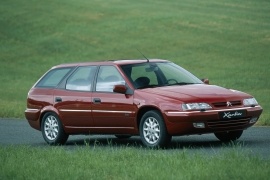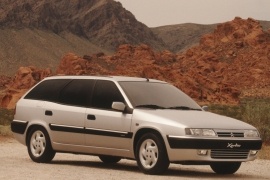CITROEN Xantia Break Models/Series Timeline, Specifications & Photos
First production year: 1995
Engines: Gasoline, Diesel
Body style: Wagon (station wagon, estate, combi, touring)
Citroen refreshed the Xantia lineup in 1998 for the entire range, including the sedan and the station wagon.
In the full era of bio-design, Citroen dared more with the angular shapes of the Xantia, but it softened its edges when it launched in 1992, and that process continued during the 1998 facelift. The station wagon, launched in 1994, was an excellent choice for families. Thanks to its fuel-efficient diesel engines and comfortable suspensions, it was forgiven for its unusual interior.
On the outside, the front fascia received new headlights and a modified grille that solved the main cooling issues for the gasoline engines. Another important upgrade was for the doors and body panels cladding, which were body-colored, not black as before. Still, the only way to have the door handles in the same color as the rest of the vehicle was to order it black.
Inside, the carmaker changed the interior materials, improving them. The instrument cluster featured the same dials and gauges but with a different layout that allowed the driver to focus on the speedometer and tachometer. Moreover, the coolant temperature and the fuel level were pushed in less visible areas. The trunk space offered 618 liters (21.8 cu-ft), which could have been expanded to 1,690 liters (59.7 cu-ft) by folding down the rear seats.
Under the hood, the French carmaker dropped the sluggish 1.6-liter powerplant and left the 1.8-liter unit for the entry-level. A turbocharged gasoline version that provided 150 hp was the range-topper. In addition, a wider range of turbodiesel engines was now available.
Citroen introduced the Xantia as a replacement for the BX in 1992 but waited for another two years before launching the station wagon version in 1994 as a 1995 model.
When Citroen launched the Xantia, the wedged shapes of the BX were not yet forgotten nor outdated. Yet, the new vehicle came with rounded edges and sloped lines. It was a different vehicle that became very popular. The station wagon was the version that attracted the families thanks to its comfortable ride and spacious trunk.
The '95 Xantia Break featured a very narrow front end with slim, rectangular headlights. The main grille was even thinner, with a single slat and the "double-chevron" badge placed in the middle. From its sides, the beltline was similar to the sedan version up to the rear doors, and then it raised in a sloped step towards the tailgate. The carmaker added a rhomboidal side window behind the rear doors as it did for its predecessor, the BX. Thus, it could keep most body panels from the sedan and changed only from C-pillars to the back.
Inside, Citroen didn't want to go for a conservative design, and, unlike most carmakers, it didn't feature a raised instrument cluster. That was in line with the rest of the dashboard and extended over the center stack. Also, it arranged the unessential gauges for the fuel and temperature on the sides of the instrument panel, leaving the speedometer and tachometer in the driver's main visibility area. The station wagon featured a folding seatback in the back and an option for 60/40 split-folding. The car offered 512 liters (18.1 cu-ft) of space with the seats up, which could reach up to 1,690 liters (59.7) with the seatback folded down.

